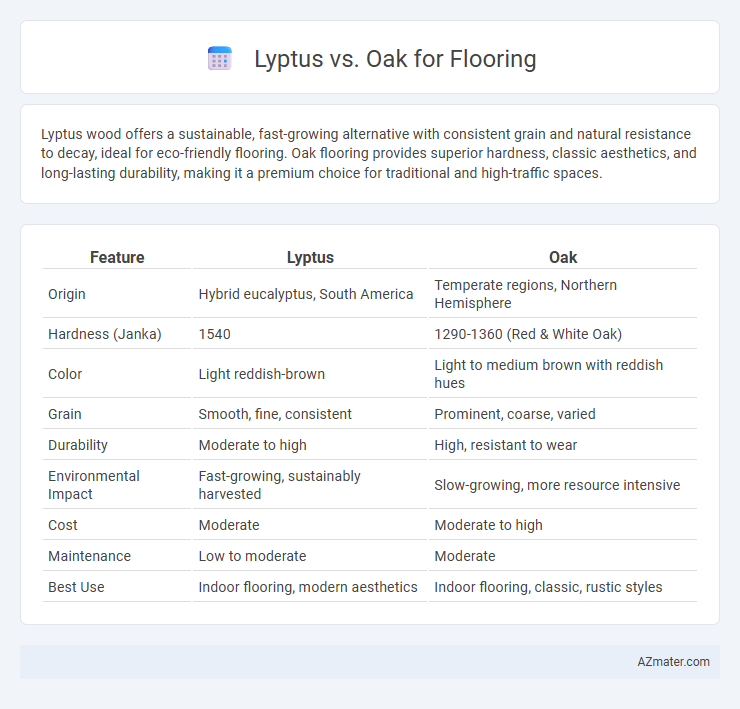Lyptus wood offers a sustainable, fast-growing alternative with consistent grain and natural resistance to decay, ideal for eco-friendly flooring. Oak flooring provides superior hardness, classic aesthetics, and long-lasting durability, making it a premium choice for traditional and high-traffic spaces.
Table of Comparison
| Feature | Lyptus | Oak |
|---|---|---|
| Origin | Hybrid eucalyptus, South America | Temperate regions, Northern Hemisphere |
| Hardness (Janka) | 1540 | 1290-1360 (Red & White Oak) |
| Color | Light reddish-brown | Light to medium brown with reddish hues |
| Grain | Smooth, fine, consistent | Prominent, coarse, varied |
| Durability | Moderate to high | High, resistant to wear |
| Environmental Impact | Fast-growing, sustainably harvested | Slow-growing, more resource intensive |
| Cost | Moderate | Moderate to high |
| Maintenance | Low to moderate | Moderate |
| Best Use | Indoor flooring, modern aesthetics | Indoor flooring, classic, rustic styles |
Introduction to Lyptus and Oak Flooring
Lyptus flooring is crafted from fast-growing hybrid eucalyptus trees, offering a sustainable and environmentally friendly alternative to traditional hardwoods. Oak flooring, derived from centuries-old hardwood trees, remains a popular choice due to its durability, classic grain patterns, and wide range of finishes. Comparing Lyptus and oak reveals differences in hardness, aesthetics, and maintenance, influencing floor longevity and design preferences.
Key Characteristics of Lyptus Wood
Lyptus wood, a hybrid between Eucalyptus grandis and Eucalyptus urophylla, offers exceptional hardness and durability, making it a strong contender for flooring compared to traditional oak. Its natural resistance to decay, fine and uniform grain, and smooth texture provide an aesthetically pleasing and long-lasting surface ideal for high-traffic areas. Lyptus is also environmentally friendly, as it grows faster than oak, allowing for sustainable harvesting without sacrificing strength or appearance.
Oak Flooring Overview: Types and Features
Oak flooring offers durability and timeless appeal, widely available in Red Oak and White Oak varieties, each known for distinct grain patterns and color tones. Red Oak features a warm, reddish hue with prominent grain, while White Oak presents a cooler, more neutral shade with a tighter grain, both suitable for high-traffic areas due to their hardness. Engineered and solid oak flooring options provide versatility in installation and environmental resilience, making oak a popular choice for both traditional and modern interiors.
Durability and Hardness Comparison
Lyptus flooring offers impressive durability with a Janka hardness rating around 1,450, making it resistant to scratches and dents in residential settings. In comparison, Oak flooring, especially Red Oak, has a Janka hardness of approximately 1,290, while White Oak rates higher at about 1,360, providing slightly less resistance to wear than Lyptus. Both hardwoods deliver strong performance, but Lyptus's higher hardness rating makes it a preferred choice for environments requiring enhanced durability.
Aesthetic Differences: Color and Grain
Lyptus flooring features a consistent, medium-to-dark reddish-brown hue with a fine, uniform grain pattern that offers a sleek, modern aesthetic. Oak flooring varies widely in color from light beige to deep amber, showcasing a more pronounced and diverse grain with distinctive knots and swirls that enhance its rustic character. The refined, uniform look of Lyptus contrasts with oak's traditional, textured appearance, making each ideal for different interior design styles.
Environmental Impact and Sustainability
Lyptus flooring is derived from a fast-growing hybrid eucalyptus tree, offering a renewable resource with a carbon-neutral lifecycle and reduced deforestation risk compared to traditional hardwoods. Oak flooring, while durable and long-lasting, often comes from slower-growing trees, contributing to greater habitat disruption and a higher carbon footprint due to prolonged growth and harvesting cycles. Choosing Lyptus supports sustainable forestry practices and lower environmental impact, making it a more eco-friendly option for flooring materials.
Cost and Availability
Lyptus flooring offers a more affordable option compared to traditional oak, with prices typically 15-30% lower per square foot. While oak remains widely available through major hardwood suppliers and local lumberyards, Lyptus availability is more limited due to its production by a single company and reliance on plantations primarily in South America. The cost-effectiveness and sustainable sourcing of Lyptus appeal to budget-conscious buyers, but oak's widespread availability and established presence in the market maintain its popularity.
Installation and Maintenance Considerations
Lyptus flooring requires professional installation due to its hardness and precise cutting needs, while oak offers more flexibility for DIY projects because of its common, user-friendly planks. Maintenance for Lyptus is simpler with its natural resistance to moisture and insects, reducing the need for frequent treatments, whereas oak demands regular sealing and can be more susceptible to scratches and dents. Both woods benefit from routine cleaning, but oak may require more attention to prevent wear in high-traffic areas.
Pros and Cons of Lyptus Flooring
Lyptus flooring offers a sustainable alternative to traditional hardwoods, featuring rapid growth rates and a hardness comparable to oak, which ensures durability and resistance to dents. Its consistent grain and warm reddish hue provide aesthetic appeal, but it can be prone to scratching and may fade over time when exposed to direct sunlight. Despite its eco-friendly benefits, availability and higher cost compared to oak can limit its widespread use in flooring projects.
Pros and Cons of Oak Flooring
Oak flooring offers exceptional durability and a timeless aesthetic with its rich grain patterns and natural warmth, making it a popular choice for both traditional and modern interiors. However, oak can be more expensive than alternative options like Lyptus and is prone to scratching and denting under heavy use, requiring regular maintenance to preserve its appearance. Its natural color variations and slower growth rate contribute to higher costs, but also result in a high-quality, long-lasting flooring solution.

Infographic: Lyptus vs Oak for Flooring
 azmater.com
azmater.com